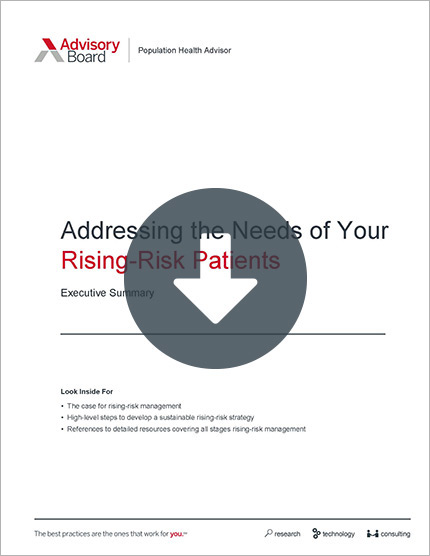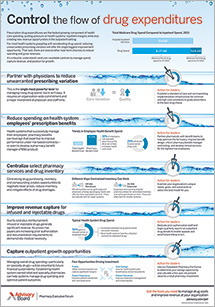Auto logout in seconds.
Continue LogoutRead Advisory Board's take: What providers should know about this report
National health care spending grew by an average annual rate of 4.4%, up from an average growth rate of 3.9% in 2017—and it is expected to continue to rise, according to preliminary projections from CMS' Office of the Actuary published Wednesday in Health Affairs.
CMS predicted that average national spending growth in the United States will increase by 5.5% annually from 2018 to 2027, outpacing growth in the country's gross domestic product (GDP) and reaching a total of nearly $6 trillion by 2027.
CMS said it made the projections "using a current-law framework," meaning the estimates do not account for potential legislative change that could occur between now and 2027.
Spending growth details for 2018
CMS estimated that national health spending reached a total of $3.6 trillion in 2018. According to Axios' "Vitals," that total equates to about $11,121 per U.S. resident.
According to CMS, the Medicare spending growth rate accelerated in 2018, increasing by an estimated average of 5.9%, up from 4.2% in 2017. CMS said the main driver of Medicare spending growth in 2018 was "faster per enrollee spending growth," which increased by an average of 3.1% in 2018, compared with 1.7% in 2017.
In comparison, CMS said Medicaid spending growth slowed in 2018. According to CMS, Medicaid spending grew by an average rate of 2.2% in 2018, which was 0.7 percentage points lower than the 2017 average. CMS said Medicaid spending growth slowed in 2018 because of slowdown in Medicaid enrollment, which was seen for the fourth consecutive year.
Meanwhile, total private health plan spending increased modestly in 2018, rising from an average growth rate of 4.2% in 2017 to an average growth rate of 4.5% in 2018. According to "Vitals," the data suggest private insurers "continue to fare the worst" in controlling costs, as total private health plan spending continued to outpace those for Medicare and Medicaid, despite relatively flat enrollment rates.
CMS also estimated that prescription drug spending grew by an average rate of 3.3% in 2018, which was much higher than the average growth rate of 0.4% in 2017. CMS said the acceleration in prescription drug spending growth was "partially driven by an increase in the number of new drugs on the market." According to CMS, there were 34 new drugs on the market from 2016 to 2017, compared with 59 new drugs in 2018.
CMS said spending on clinical, physician, and hospital services totaled $2.16 billion in 2018, accounting for 59% of total health care spending.
Spending growth details for 2019 and beyond
CMS predicted that national health spending growth will again increase by a faster pace in 2019, at an average spending growth rate of 4.8%, compared with 4.4% in 2018.
Beyond 2019, CMS predicted that the average national spending growth rate in the United States will increase by an average of 5.7% annually from 2020 to 2027.
Overall, CMS projected that health care spending will account for 19.4% of the U.S. economy by 2027, up from 17.9% in 2017. According to CMS, U.S. health care spending will reach a total of nearly $6 trillion by 2027. CMS said federal, state, and local governments will finance an estimated 47% of total health spending by 2027, up from about 45% in 2017, Forbes reports.
Health insurance spending through 2027
CMS projected that Medicare spending growth will increase by an average of 7.1% in 2019, and an annual average rate of 7.6% from 2020 to 2027.
Meanwhile, Medicaid spending also is expected to grow in 2019, at an average rate of 4.8%, CMS said. According to CMS, that growth will be drive in part by Medicaid expansions in Idaho, Maine, Nebraska, Utah, and Virginia. CMS said Medicaid spending is expected to grow by an estimated average rate of 6% annually from 2020 to 2027.
CMS predicted that enrollment in private health plans will decline in 2019 because of the elimination of the Affordable Care Act's individual mandate penalty. Beyond 2019, CMS predicted that private health insurance spending growth will increase by an average rate of 5.1% annually from 2020 to 2027, reaching a peak of an average 5.4% growth rate from 2023 to 2024. CMS said the peak will represent a "lagged response to … high anticipated growth in disposable personal income" from 2020 to 2022.
Clinical, physician, and hospital services spending through 2027
CMS said Medicaid expansions will contribute to increased spending on clinical and physician services in 2019, which will increase by an average rate of 5.4% in 2019, up from 4.9% in 2018. Those expansions, as well as accelerated growth in Medicare hospital payment updates, also will fuel an increase in hospital spending, which is expected to rise from a 4.4% average growth rate in 2018 to a 5.1% average growth rate in 2019.
Beyond 2019, CMS said spending on clinical and physician services, as well as hospitals, will continue to rise. CMS predicted that overall spending on clinical and physician services will grow by an average rate of 5.4% from 2020 to 2027, while hospital spending growth will increase by an average of 5.7% annually from 2020 to 2027. CMS estimated that hospital price growth also will accelerate over that time, in part because of wage increases.
In addition to the price growth, CMS said spending growth rate increases for clinical and physician services and hospitals will be driven in part by increases in Medicare spending. CMS said the higher Medicare spending growth on such services will be driven by "comparatively higher enrollment growth in Medicare as baby boomers shift out of private health insurance and into Medicare." For example, CMS said Medicare hospital spending growth will increase by an average of 7.5% annually over from 2020 to 2027.
Prescription drug spending through 2027
CMS projected that prescription drug spending growth will continued to increase in 2019, rising to an average growth rate of 4.6%. CMS predicted that growth would stem from "an increase in projected use, including from new drugs, and somewhat faster price growth."
CMS projected that prescription drug spending growth will increase by an average of 6.1% annually from 2020 to 2027. The agency said that accelerated growth rate will stem largely from "projected faster growth in utilization related to the aging of the population and changes in pharmacotherapy guidelines."
Reasons for overall spending growth
CMS said growth in prices for health care goods and services is projected to account for nearly 50% of estimated growth in personal health care spending from 2018 to 2027. According to CMS, prices for health care goods and services is projected to increase by an average of 2.5% annually over that time.
CMS said growth in U.S. health spending and health insurance enrollment also likely will "continue to be driven by long-observed, fundamental economic and demographic factors," such as projected growth in U.S. residents' incomes, as well as more baby boomers shifting from private health plans and enrolling in Medicare. CMS estimated that a predicted 1.7% average annual increase in use and intensity of health care services will account for nearly a third of overall health spending growth from 2018 to 2027, while population growth and changes in demographics will account for the remaining portion of the projected health spending growth.
Andrea Sisko, an economist at CMS' Office of the Actuary and lead author of the report, said, "As a result of economic and demographic trends, we expect health spending growth to increase over this next decade." Sisko added, "While Medicare spending is expected to accelerate the fastest among payers and contribute to the increase, growth in health prices and disposable personal income are also significant contributors" (Morse, Healthcare Finance News, 2/20; Sisko et al., Health Affairs, 2/20; CMS Forecast Summary, accessed 2/21; Baker, "Vitals," Axios, 2/21; Japsen, Forbes, 2/20; Cohrs, Inside Health Policy, 2/20 [subscription required]).
Advisory Board's take

Yulan Egan, Practice Manager, Health Care Advisory Board
This year's NHE projections—following closely on the heels of the Health Care Cost Institute's annual analysis of commercial health care spending and a 2019 update of the oft-quoted 2003 article "It's the Prices, Stupid"—is just the latest in a series of reports to emphasize the role that price inflation plays in driving health spending growth. What is particularly interesting about the Office of the Actuary's projections is their mention of several factors which they assume held down price growth in recent years, but which they expect to weaken in the coming years. Perhaps most notable among these is increased price sensitivity due to cost-sharing, which CMS believes will exert less downward pressure on price growth moving forward.
“The projections may push employers and governmental payers to focus on strategies to constrain price growth with renewed vigor”
This may come as a surprise to some providers, who often express a sense that price sensitivity in their market has far from reached its full potential. But it does, to a certain extent, track with recent conversations our research teams have had with employers and health plans. These players increasingly believe they may be approaching the limits of how much cost individuals are willing to bear (at least given the current robust state of the labor market)—and how much they can rely on high-deductible health plans to drive cost savings moving forward. They've also expressed desire to continue searching for, and experimenting with, other mechanisms to exert downward pressure on pricing growth. If anything, these latest projections may push employers and governmental payers to focus on strategies to constrain price growth with renewed vigor.
“CMS anticipates notable accelerations in per-enrollee spending in Medicare and Medicaid”
While the headline story may be price, it's important not to ignore the Office of the Actuary's projections about utilization. CMS anticipates some notable accelerations in per-enrollee spending in Medicare and Medicaid, much of which they attribute to anticipated increases in the use and intensity of health care services. While enrollment growth in both programs has been high in recent years with the aging of the baby boomers and expansion of Medicaid in many states, per-person spending growth has been relatively low as younger and healthier beneficiaries have joined each segment. Moving forward, both of these populations will begin to skew older and sicker—creating the need for providers to adapt their care delivery models for an aging population which likely requires higher levels of medical over procedural care.
To learn about how you can meet the needs of these higher-risk and rising-risk patients, be sure to read our new briefing on Addressing the Needs of Your Rising Risk Patients. Then, to learn more about how to operate in a market where rising costs have led to stagnant inpatient volumes, download our new three-part series on Re-igniting the Growth Engine.
Don't miss out on the latest Advisory Board insights
Create your free account to access 1 resource, including the latest research and webinars.
Want access without creating an account?
You have 1 free members-only resource remaining this month.
1 free members-only resources remaining
1 free members-only resources remaining
You've reached your limit of free insights
Become a member to access all of Advisory Board's resources, events, and experts
Never miss out on the latest innovative health care content tailored to you.
Benefits include:
You've reached your limit of free insights
Become a member to access all of Advisory Board's resources, events, and experts
Never miss out on the latest innovative health care content tailored to you.
Benefits include:
This content is available through your Curated Research partnership with Advisory Board. Click on ‘view this resource’ to read the full piece
Email ask@advisory.com to learn more
Click on ‘Become a Member’ to learn about the benefits of a Full-Access partnership with Advisory Board
Never miss out on the latest innovative health care content tailored to you.
Benefits Include:
This is for members only. Learn more.
Click on ‘Become a Member’ to learn about the benefits of a Full-Access partnership with Advisory Board
Never miss out on the latest innovative health care content tailored to you.


